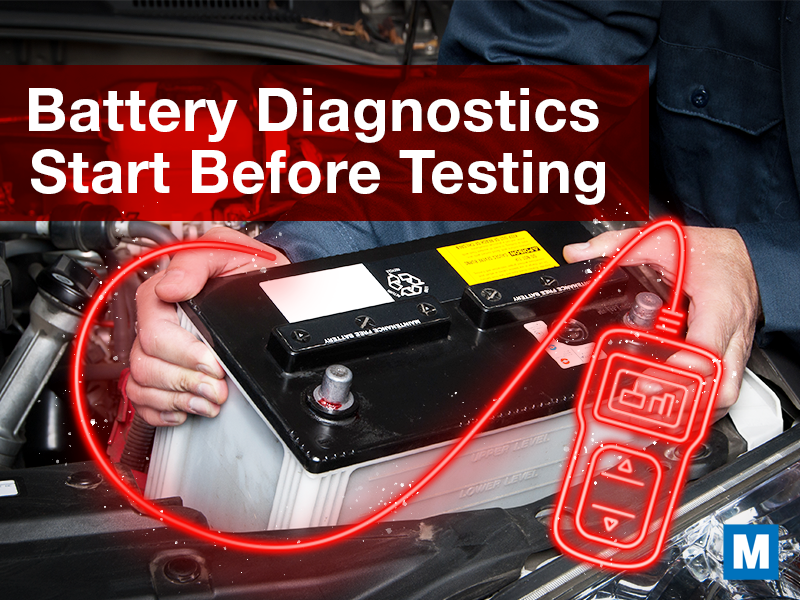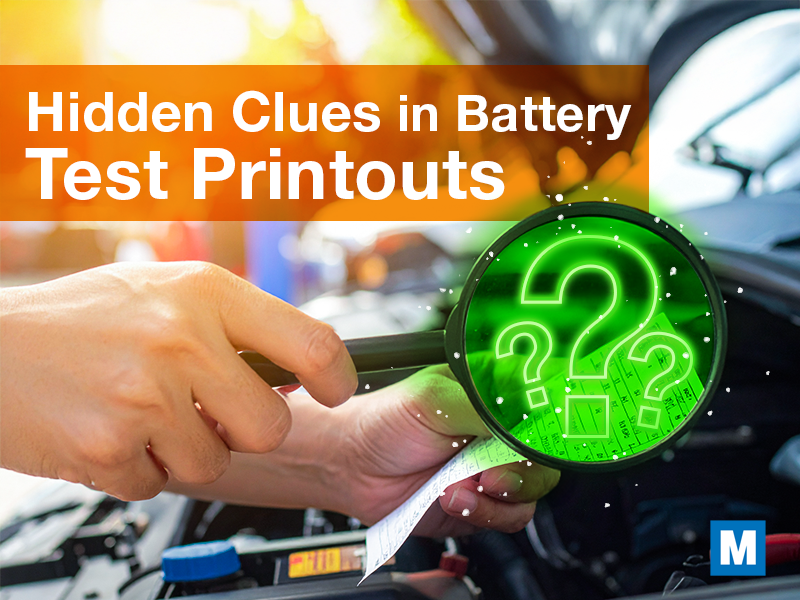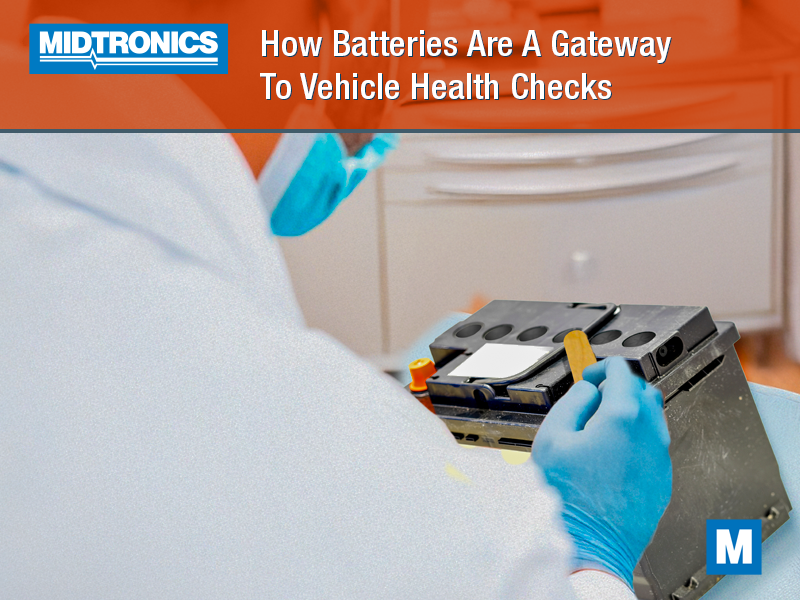Every technician knows the value of a solid battery tester. A good diagnostic tool can give you voltage, state of charge, state of health, and a wealth of other information within seconds. But the truth seasoned techs have learned the hard way is that accurate battery tests don’t start the moment you clamp the leads onto the posts. They start well before that. The most reliable battery results come from a combination of prep, observation, and assessing the vehicle’s overall condition before the first reading is taken.
For shops, this distinction can mean the difference between a confident repair order and a costly comeback. For technicians, it’s the difference between diagnosing the right component the first time and replacing a battery that wasn’t actually the problem. Let’s break down why the early steps matter, and what every service professional should do before even powering up the tester.
The Battery Doesn’t Live in Isolation
The biggest misconception about battery testing is that you’re only looking at the battery. In reality, you’re looking at a component woven into a system that includes the alternator, starter, wiring harnesses, modules, and in modern vehicles, the battery management system. A healthy battery can be dragged down by a weak alternator, just as a failing battery can cause the alternator to overwork.
Before you even grab your tester, you need to think about the big picture. Has the vehicle been sitting for weeks? Is there a history of short-trip driving? Has the customer reported electrical gremlins like flickering lights or erratic cluster activity? Each of these clues can shape the way you interpret your battery test results later.
In the case of hybrids and EVs, the 12-volt battery still plays a vital role in controlling electronics, even if propulsion power comes from the high-voltage pack. Failing to consider the context can make your test results misleading. A healthy battery might fail a test if a parasitic drain is pulling it down, or a marginal battery might pass if the vehicle’s been freshly driven and topped up by the charging system.
Environmental and Usage Factors Matter
A battery’s state is never static. It’s influenced by its environment and how the vehicle is used. That’s why a key part of diagnostics happens before the tester is in play: asking the right questions and making the right observations.
Cold weather, for example, can mask the true performance of a failing battery because chemical reactions inside slow down, and cranking power is reduced. Extreme heat can accelerate electrolyte evaporation and plate corrosion. A technician who doesn’t take note of these conditions might misinterpret why a battery tests poorly and either over-recommend replacement or overlook a brewing failure.
Usage is another factor. Vehicles that see a lot of short trips may never fully recharge the battery, leading to sulfation and reduced capacity over time. Fleet vehicles that idle for long periods can drain batteries in a slow but steady way. Even newer batteries can suffer premature failure under these conditions, and if you don’t gather that information ahead of time, your interpretation of the results might not match reality.
Visual Inspections Catch What Testers Can’t
While modern battery testers are extremely capable, there are still things they can’t see. That’s where a quick visual inspection becomes part of the diagnostic process. Corroded terminals, loose clamps, frayed cables, and even small cracks in the case can impact performance but won’t necessarily show up as a failure on the tester’s screen.
Before testing, it’s worth taking a beat to inspect the posts and terminals.
- Is there evidence of acid leaking around the posts?
- Are the clamps tight and corrosion-free?
- Is the battery secure, or is it able to move in the tray?
- Is the battery hold-down loose or missing?
This is also the moment to check for signs of overcharging or undercharging. Discoloration around the vent caps or a bulging case can indicate the alternator has been putting out too much voltage. On the other hand, a chronically low battery may show buildup around the posts. These conditions point to issues that go beyond the battery itself, and knowing about them before you run your test will make your recommendations much stronger.
Setting the Stage for an Accurate Reading
The way you prepare the battery for testing can influence the accuracy of results. A battery that’s just come off a long drive may have a surface charge that doesn’t represent true capacity. Similarly, a battery that’s been sitting unused in cold conditions may show a lower voltage than it’s truly capable of delivering.
Best practice is to remove surface charge before testing. Apply a small load like turning on the headlights for a minute or two before hooking up the tester. Or if the vehicle’s been sitting cold for a while, allow it to warm up slightly or account for temperature in your interpretation.
Also, make sure all electrical loads are off and the ignition is in the proper position for the test. Modern vehicles with multiple control modules can draw current even when “off,” so it’s important to follow the tester instructions.
Interpreting Results in Context
One of the most common pitfalls in battery testing is reading the tester’s result in a vacuum. A “good” result doesn’t guarantee the customer won’t be back in two weeks with a no-start.
This is where all your pre-test work pays off. If you know the battery is two years old but the customer only drives it short distances twice a week, a “good” test might prompt you to recommend a maintenance charge routine or check for parasitic drains. On the other hand, if the battery is four years old in a cold climate and tests marginal, you might recommend proactive replacement even if it hasn’t failed yet.
The goal isn’t just to know the battery’s state today – it’s to predict how it will perform under the customer’s typical driving conditions and in the upcoming season. That’s what turns a battery test from a snapshot reading into a real diagnostic tool.
Avoiding Comebacks and Building Trust
Every service professional has dealt with a battery comeback. The customer leaves with a “good” battery according to the test, only to return days later with a no-start. These situations are frustrating, time-consuming, and often damage the customer’s trust in your shop.
Many comebacks can be avoided by starting diagnostics before connecting the tester. By combining a quick customer interview, a visual inspection, an understanding of the vehicle’s usage patterns, and a properly prepared battery, you’re far more likely to make the right call the first time.
When you explain your process to the customer – “We checked the connections, looked for signs of overcharging, and confirmed the battery was at the right temperature before testing” – you also reinforce the value of your work. Customers don’t see “hook up the tester” as a complex task, but they will appreciate the thoroughness and attention to detail when you go beyond that step.
The Test Is Just the Middle of the Process
Battery testing is a fundamental part of modern vehicle service, but the test itself should be thought of as the middle of the process, not the beginning. Accurate diagnostics are built on the groundwork of understanding the context, inspecting the battery’s condition, preparing it properly, and interpreting results with an informed eye.
For technicians, this approach means fewer false positives, fewer missed failures, and a stronger reputation for accurate, reliable work. For shops, it means happier customers, fewer comebacks, and a better bottom line.
At the end of the day, your tester is only as good as the process that surrounds it. Start before you connect it, and you’ll get results that tell the whole story.




